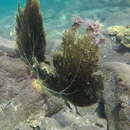en
names in breadcrumbs


In Anthozoans, specialized sensory organs are absent and nerves are arranged in nerve nets. Most nerve cells allow impulses to travel in either direction. Hairlike projections on individual cells are mechanoreceptors and possible chemoreceptors. Some Anthozoans show a sensitivity to light.
Communication Channels: tactile ; chemical
Perception Channels: tactile ; chemical
No current conservation details available.
US Migratory Bird Act: no special status
US Federal List: no special status
Once a planulae polyp is settled on a hard surface, the young polyp creates a horizonatal layer of aragonite called the basal disk. As the polyp grows upward, the base's margin also turns upward, forming a cup called the epitheca, which contains daily growth bands. These and other sturctures called septa form the skeletal boundaries found at the bottom of the coral polyps, which are left behind as a result of the upward growth of the polyp.
Could not find any adverse effects on humans.
Compounds have been separated from G. ventalina to make antibiotics. These compounds include octacoral.
Gorgonia ventalina is popularly collected for use in aqauriums and as souvenirs.
As a colorful addition to coral reef habitats, its presence also is important to ecotourism.
Positive Impacts: pet trade ; ecotourism ; source of medicine or drug
Gorgonia ventalina has several ecosystem roles, primarily by serving as a substrate for many other organisms. For example, bivavle molluscs, sponges, and algae may grow on dead sections of the sea fan. However, it is not known if the growth of these organisms kills the sections or if they invade after the coral is already dead. Certain organisms, such as the brittle star and the basket starfish, use the tall G. ventalina to climb to a more advantageous position for filter feeding in reef areas. There have been studies into the role that sea fans, including G. ventalina, have in the formation of coral reefs. Conclusions were the limestone inner structure provides some of the base where other corals may attach to form more colonies.
Ecosystem Impact: creates habitat
Mutualist Species:
Gorgonia ventalina is carnivourous, feeding on zooplankton, especially at night. A passive feeder, Gorgonia ventalina orients itself in the path of the sea current, so that the current flows past the fan and the zooplankton in the current are caught and eaten. In addition to being a carnivorous passive feeder, G. ventalina also has zooxanthellae, which extensively colonize the sea fan, especially in the epidermis, polyps, and gastrodermal canals and the anthocodial septae. These zooxanthellae, usually Symbiodinium sp., are also able to provide the sea fan with nutrients through its photosynthetic activities.
Animal Foods: aquatic crustaceans; zooplankton
Primary Diet: carnivore (Eats non-insect arthropods); planktivore
The geographic range of Gorgonia ventalina is from Bermuda to Curacao, including the Florida Keys and Western Caribbean. However, it is not found in the Gulf of Mexico. In geographic ranges, it is found in the southeastern part of the of the nearctic region and the northwestern part of the neotropical region.
Biogeographic Regions: neotropical (Native ); atlantic ocean
Gorgonia ventalina is distributed in a clumped, non-random distribution on coral reefs. Usually the most common gorgonian in coral reef habitats, it is primarily found on band and patch reefs. In addition, the G. ventalina can be found in near-shore areas with heavy wave action and also on deeper reefs (depths greater than 15 m).
Habitat Regions: tropical ; saltwater or marine
Aquatic Biomes: reef ; coastal
There are several potential causes of death for G. ventalina. The greatest cause of mortality is the disattachment of a colony from the substrate, most likely by wave action and storms. The overgrowth of the sea fan by other organisms is also another leading cause of death, especially by the hydrocoralline Millipora alcicornis and some encrusting bryozoa. The cause of death is attributed to the lack of food and oxygen to the polyp. Recently, mortality has also been attributed to tumor growth. The tumors observed on G. ventalina exposed to environmental stresses include the presence of pollutants, rising water temperature, increased nutrient concentrations, and increased turbidity. The large tumor masses, which were most often concentrated at the axial bases of the affected clonies were clearly associated with tissue death (necrosis) and erosion of the affected coral. According to Cary, there is no evidence that gorgonian colonies ever die from old age.
Gorgonia ventalina is usually purple but can vary to its less common colors of yellow-orange, yellow, and brown. In some cases, the color of the sea fan is a result of the environment and the chemicals in the enviroment. The principle pigments of the sea fan are fixed in the spicules (needle-like parts of solid calcium carbonate). Colors result from chemical pigments produced in the spicules. Since the color of the fan varies, the shape of the spicules is the only positive identifier of G. ventalina. The spicules are small and fusiform. The polyps of the G. ventalina protrude from the spicules as tiny fragile white flowers. It is these individual polyps that form the sea fan.
Gorgonia ventalina can be up to 180 cm tall and 150 cm wide, with anastomose branches, which form uniplanar, reticulate, fan-shaped colonies. The branches are round or slightly compressed in the plane of the fan branch.
Range length: 180 (high) cm.
Other Physical Features: ectothermic ; heterothermic ; radial symmetry
Gorgonia ventalina contains secondary metabolites and calcified sclerites that act as anti-predator defenses. These anti-predator defenses act as successful feeding deterrents to the Cyphoma gibbosum, a common predator of the G. ventalina. Cyphoma gibbosum feeds on gorgonian polyps by crawling slowly over the skeleton. Trotonia hamnerorum is a specialized predator on G. ventalina.
Known Predators:
Gorgonian corals reproduce asexually by cloning or fragmentation, with external fertilization. The larvae typically spend several days as plankton before settling on a hard surface to begin formation of a colony.
Key Reproductive Features: asexual ; fertilization (External ); oviparous
Parental Investment: no parental involvement